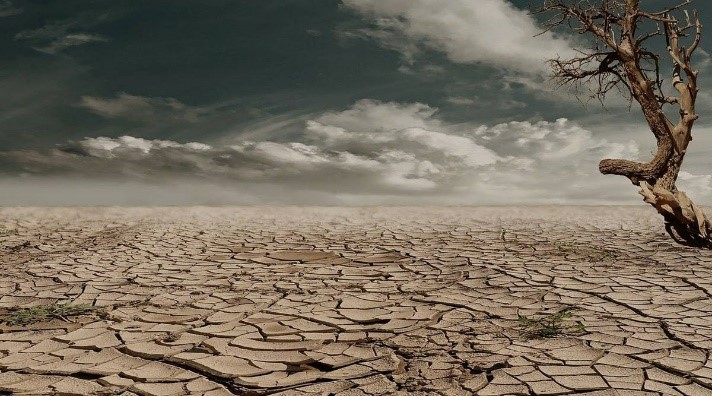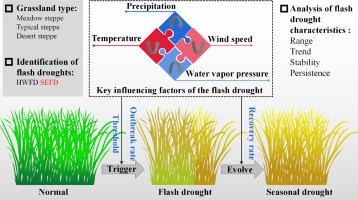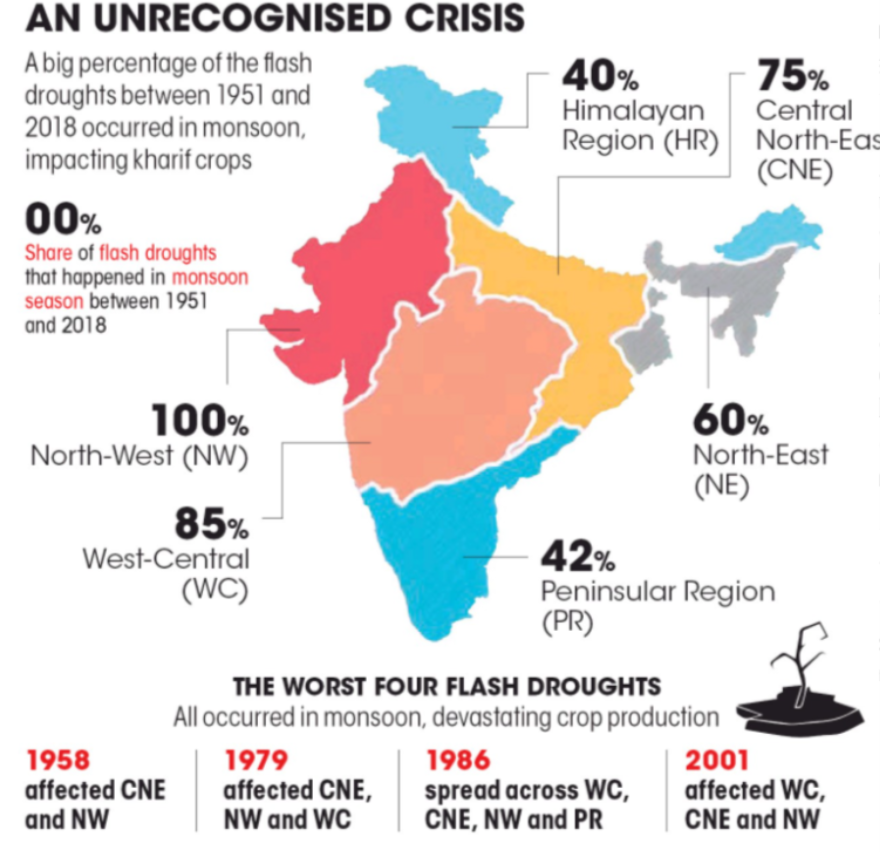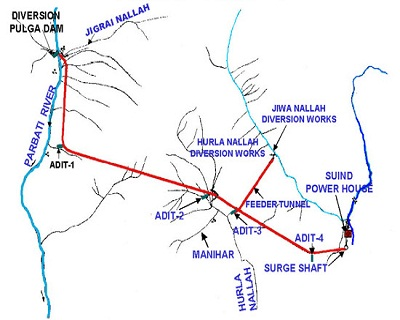Description

Disclaimer: Copyright infringement not intended.
Context
- According to a paper published recently in Nature Communications, India is a hotspot for flash droughts and this could have major implications for the country’s crop production.
Flash Drought
About
- Flash drought refers to relatively short periods of warm surface temperature and anomalously low and rapid decreasing soil moisture (SM).
Characteristics
- Flash droughts are characterized by rapid intensification of drought to severe levels over large areas, triggered by anomalously high temperatures (heatwave flash drought) or lack of precipitation (precipitation-deficit flash droughts), or both.

How is it different from Conventional Drought?
- What makes flash drought unique from conventional drought development is a lack of rainfall coupled with increased evapotranspiration.
- Evapotranspiration is the combination of evaporation from the land surface and transpiration from vegetation. Both of these processes act to transfer water from the land surface to the atmosphere.
- These processes are critical in flash drought development, as enhanced evapotranspiration with a lack of rainfall can quickly deplete soil moisture and lead to devastating impacts on agriculture and ecosystems.
Drivers of Flash Drought
- Global warming
- Precipitation deficit
- Failed Monsoon
- Amplification of evaporative demand
- High precipitation variability
- Oscillation of the Inter-Tropical Convergence Zone (ITCZ):
- Anticyclones
- Over-exploitation of groundwater.
- Sub-optimum conservation of surface water.
- Abandoning of Traditional water harvesting systems.
- Unsustainable agricultural practices.
- Excessive use of High Yielding Seeds (HYV) that require water.
- Lack of water storage structures

Impact
- These fast-evolving droughts cause large-scale agricultural losses, expansive wildfires, and challenges for seasonal and sub-seasonal climate predictions.
- Other:
- Increased farm distress.
- Increased budgetary pressures.
- ‘Multiplier effect’ on the economy: Droughts cost 2-5 percent of India’s GDP.
- Low domestic production (especially Agro-Based Industries).
- Unfair Business Practices
- Reduced availability of drinking water
- Deforestation, wildfires and increase desertification.
- Stress on endangered species and cause loss of biodiversity.
- Water conflicts.
- Social Tension.
- Intensification of household food insecurity.
- Loss of livelihood in the agricultural sector.
Flash Drought Stress Index, or, FDSI
- FDSI is an index for flash drought monitoring by leveraging the footprint-scale thresholds of soil hydrologic regimes (energy-limited wet phase, moisture-limited transitional, and dry phase) and land-atmospheric coupling strength derived from NASA’s SMAP satellite.
- There are two complementary indices based on SMAP soil moisture for measuring the severity and the rate of intensification of drought, namely, Soil Moisture Stress (SMS) and Relative Rate of Drydown (RRD), SMS and RRD are non-linearly combined to provide FDSI (Flash Drought Stress Index) ─ a composite indicator used for global flash drought monitoring.
- FDSI can be formulated with a relatively short observational record of soil moisture (as opposed to climatology length observations).
- It is sensitive to changing land-surface heterogeneity, land-atmospheric interactions, and evolving meteorological anomalies.
- FDSI is extensively validated globally across multiple timescales (daily, weekly, and monthly) using a suite of vegetation and meteorological drought indices.
Findings of the new study
Flash flood Hotspot
- Flash drought hotspots exist over Brazil, the Sahel, the Great Rift Valley with local hotspots over the central United States, southwestern Russia, and northeastern China.
The case of India
- By the end of the 21st century, the frequency of concurrent hot and dry extremes in India will rise by about five-fold. This can cause approximately a seven-fold increase in flash droughts

Monsoon season Flash Drought
- India could experience more flash droughts during the monsoon season than the non-monsoon season.
- Though soil moisture is replenished during the summer monsoon, a break in the monsoon along with high temperatures can quickly deplete the soil moisture. This rapid depletion of soil moisture results in flash droughts during the monsoon season.
- About 10 percent–15 percent of rice and maize grown area in each year is affected by flash droughts during the monsoon season in India. Flash droughts during the monsoon season in India can directly affect crop production and indirectly pose challenges to meeting increased irrigation water demands.
Impact
- If a multi-week period of rapid drought development occurs, the agricultural sector can experience substantial economic losses and environments become more favorable for wildfire and heatwave development.
Challenges Related to Flash Drought Management
- Treated as a short-term issue and handled as a crisis situation only.
- Poor early warning system.
- Poor assessment.
- No reliable data on water.
- The misconception that tackling drought is beyond our control.
- Managing Drought comes under the State List.
Way Forward
- Judicious use of water resources.
- Proper management of Irrigation.
- Setting up Water Users Association (WUA).
- Conjunctive Use of Surface and Groundwater.
- Increase Water storage capacity.
- A National Water Grid could be set up.
- Transfer of water from surplus to water deficit region.
- Early-warning systems (EWS).
- Set up Drought Monitoring Centres (DMCs).
- Periodic review of the progress of drought mitigation activities
- Integrated basin planning.
- Real-time data for groundwater management: example: Andhra Pradesh online water dashboard.
- Community-based drought management plans- example: Pani Panchayat of Odisha.
- Awareness and capacity building on water conservation and harvesting.
- Cultivation of drought resistant crops.
- Inter-agency cooperation.
- Necessary budget allocations and implementation support to Panchayati Raj Institutions in drought-prone regions.
- Community-based consultations through Gram Sabha.
- Satellite imagery.

Closing Remark
- India urgently needs an adaptation framework in place to manage the available water resources and also explore the use of drought-tolerant varieties.
|
PRACTICE QUESTION
Q. How is a Flash Drought different from a Conventional Drought? What are the drivers of Flash Drought and what are the challenges related to Flash Drought Management? Suggest measures to tackle Flash Droughts.
|
https://indianexpress.com/article/technology/science/flash-droughts-affect-india-7639227/


















